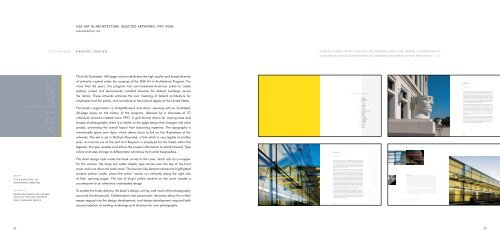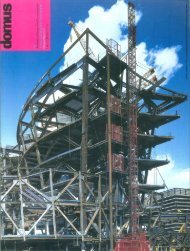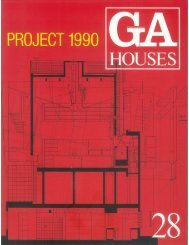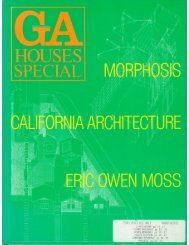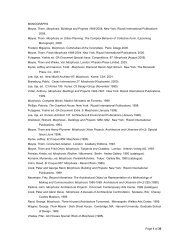Winners of the 2008 Biennial Design Awards - GSA
Winners of the 2008 Biennial Design Awards - GSA
Winners of the 2008 Biennial Design Awards - GSA
You also want an ePaper? Increase the reach of your titles
YUMPU automatically turns print PDFs into web optimized ePapers that Google loves.
U.S . CenSUS BUreaU CompUt er FaCili ty<br />
Bowie, m ary land<br />
69<br />
NeoN tubes, traNsformers, aNd wiriNg<br />
26 ft x502ft<br />
John M. ShAW U.S. CoURThoUSE<br />
LAFAyETTE, LoUiSiAnA<br />
105<br />
71<br />
<strong>GSA</strong> ArT IN ArChITECTUrE: SELECTEd ArTWOrkS 1997–<strong>2008</strong><br />
WAShINGTON, dC<br />
CitAtion<br />
grAphiC design<br />
A CrISPLY CLASSIC dESIGN ThAT PUTS ThE ArTWOrkS FrONT ANd CENTEr. A CELEBrATION OF<br />
A dECAdE OF STELLAr AChIEvEMENTS IN COMMISSIONING GrEAT ArT FOr ThE NATION. / JUrY<br />
ART ARCH<br />
<strong>GSA</strong> ART IN ARCHITECTURE SElECTEd ARTWoRkS 1997–<strong>2008</strong><br />
This fully illustrated, 160-page volume celebrates <strong>the</strong> high quality and broad diversity<br />
<strong>of</strong> artworks created under <strong>the</strong> auspices <strong>of</strong> <strong>the</strong> <strong>GSA</strong> Art in Architecture Program. For<br />
more than 36 years, this program has commissioned American artists to create<br />
publicly scaled and permanently installed artworks for federal buildings across<br />
<strong>the</strong> nation. These artworks enhance <strong>the</strong> civic meaning <strong>of</strong> federal architecture for<br />
employees and <strong>the</strong> public, and contribute to <strong>the</strong> cultural legacy <strong>of</strong> <strong>the</strong> United States.<br />
The book’s organization is straightforward and direct, opening with an illustrated,<br />
30-page essay on <strong>the</strong> history <strong>of</strong> <strong>the</strong> program, followed by a showcase <strong>of</strong> 27<br />
individual artworks created since 1997. A grid format allows for varying sizes and<br />
shapes <strong>of</strong> photographs; <strong>the</strong>re is a rhythm to <strong>the</strong> page design that changes with each<br />
project, preventing <strong>the</strong> overall layout from becoming repetitive. The typography is<br />
intentionally spare and clean, which allows focus to fall on <strong>the</strong> illustrations <strong>of</strong> <strong>the</strong><br />
artworks. The text is set in Gotham rounded, a font which is very legible at smaller<br />
Selected ARtWoRkS 1997-<strong>2008</strong><br />
ellSWoRth Kelly<br />
Sol leWitt<br />
AlAn Michelson<br />
RobeRt Mangold<br />
MikYoung KiM<br />
Alice aycocK<br />
JeAn shin<br />
keith sonnier<br />
MARtin Puryear<br />
MAYA lin<br />
Al held<br />
ARtuRo herrera<br />
iñigo Manglano-ovalle<br />
PAe White<br />
VAleRie Jaudon<br />
XiAoze Xie<br />
diAnA Moore<br />
leo villareal<br />
JiM caMPbell<br />
tiM rollins + K.o.s.<br />
JennY holzer<br />
toM otterness<br />
JAMeS turrell<br />
edWARd ruscha<br />
MichAel FaJans<br />
Ming Fay<br />
MAt<strong>the</strong>W ritchie<br />
ARTWORK Urns <strong>of</strong> JUstice<br />
ARTIST DiAnA Moore<br />
INSTALLED 1999<br />
Diana Moore’s depiction <strong>of</strong> Justice in <strong>the</strong> form <strong>of</strong> monumental urns derives partly<br />
from her visits to <strong>the</strong> Louisiana bayou. While exploring Shadows-on-<strong>the</strong>-Teche<br />
and o<strong>the</strong>r historic sites in <strong>the</strong> vicinity <strong>of</strong> Lafayette, Moore was intrigued by <strong>the</strong> tall,<br />
decorative ceramic vessels she saw <strong>the</strong>re, which are similar to urns she had seen<br />
in sou<strong>the</strong>rn France. Anthropomorphic vessels have been unear<strong>the</strong>d in archaeological<br />
excavations all over <strong>the</strong> world, suggesting that this practice is somehow<br />
innate to human culture. Moore purposefully made <strong>the</strong> gender, age, and ethnicity<br />
<strong>of</strong> her figures ambiguous to encompass <strong>the</strong> splendid diversity <strong>of</strong> American society.<br />
This inclusiveness also alludes to <strong>the</strong> extraordinary breadth and depth <strong>of</strong> cultural<br />
influences that have shaped <strong>the</strong> history <strong>of</strong> Lafayette.<br />
Since antiquity, <strong>the</strong> personification <strong>of</strong> Justice has been a common depiction in art.<br />
She is normally represented holding a pair <strong>of</strong> scales in one hand and ei<strong>the</strong>r a sword<br />
or a book in <strong>the</strong> o<strong>the</strong>r. During <strong>the</strong> Renaissance, <strong>the</strong> standard depiction <strong>of</strong> Justice<br />
included a blindfold to denote her impartiality. While Justice’s blindfold is now a<br />
conventional attribute, its depiction in Moore’s Urns <strong>of</strong> Justice also makes reference<br />
to <strong>the</strong> local culture <strong>of</strong> Lafayette. The region’s earliest hand-loomed fabrics<br />
were <strong>of</strong>ten a simple striped pattern, which Moore has adopted for her blindfolds.<br />
Coupled with <strong>the</strong> stars that festoon <strong>the</strong> bases <strong>of</strong> <strong>the</strong> urns, <strong>the</strong> stripes also evoke<br />
<strong>the</strong> American flag.<br />
Moore’s sculptures for <strong>the</strong> courthouse sit atop <strong>the</strong> plinths that flank <strong>the</strong> building’s<br />
entrance. The urns face slightly outward to greet approaching visitors. Each urn<br />
measures approximately five feet in height, allowing <strong>the</strong> sculptures to provide a<br />
transition from human to architectural scale. Urns <strong>of</strong> Justice transforms <strong>the</strong> ancient<br />
use <strong>of</strong> vessels as architectural ornament into a robust expression <strong>of</strong> civic ideals and<br />
iconic emblems <strong>of</strong> <strong>the</strong> federal judiciary in Lafayette. MM<br />
sizes. A minimal use <strong>of</strong> <strong>the</strong> serif font requiem is employed for <strong>the</strong> labels within <strong>the</strong><br />
legends; this type recedes and allows <strong>the</strong> project information to stand forward. Type<br />
design<br />
COX & ASSOCIATES, INC.<br />
SILvEr SPrING, MArYLANd<br />
gsA oFFiCe<br />
dESIGN EXCELLENCE ANd ThE ArTS<br />
OFFICE OF ThE ChIEF ArChITECT<br />
PUBLIC BUILdINGS SErvICE<br />
colors and sizes change to differentiate narratives from artist biographies.<br />
The clean design style inside <strong>the</strong> book carries to <strong>the</strong> cover, which acts as a wrapper<br />
for <strong>the</strong> volume: <strong>the</strong> large but subtle display type carries over <strong>the</strong> top <strong>of</strong> <strong>the</strong> front<br />
cover and runs down <strong>the</strong> back cover. This banner-like element echoes <strong>the</strong> highlighted<br />
projects section inside, where <strong>the</strong> artists’ names run vertically along <strong>the</strong> right side<br />
<strong>of</strong> <strong>the</strong>ir opening pages. The use <strong>of</strong> bright yellow accents on <strong>the</strong> cover creates a<br />
counterpoint to an o<strong>the</strong>rwise understated design.<br />
To enable <strong>the</strong> timely delivery, <strong>the</strong> book’s design, writing, and much <strong>of</strong> <strong>the</strong> photography<br />
occurred simultaneously. Collaboration was paramount: decisions about <strong>the</strong> written<br />
essays segued into <strong>the</strong> design development, and design development required both<br />
A R T WO R K<br />
A R T I S T<br />
I N S TA LL E D 1997<br />
CenozoiC Codex<br />
Keith Sonnier<br />
Cenozoic Codex illuminates <strong>the</strong> U.S. Census Bureau Computer Facility from dusk<br />
until dawn with vibrant neon light. <strong>the</strong> striking installation charts <strong>the</strong> passing <strong>of</strong><br />
each day and <strong>the</strong> changing <strong>of</strong> seasons. <strong>the</strong> work’s presence at night and absence<br />
during sunlight hours signifies <strong>the</strong> cyclic nature <strong>of</strong> time. during <strong>the</strong> short winter<br />
days, daytime employees get a glimpse <strong>of</strong> <strong>the</strong> artwork each morning when <strong>the</strong>y<br />
arrive and again at <strong>the</strong> end <strong>of</strong> <strong>the</strong>ir shifts. as <strong>the</strong> days leng<strong>the</strong>n, <strong>the</strong> artwork<br />
belongs to <strong>the</strong> nighttime employees alone.<br />
Keith Sonnier creates large-scale installations that respond to <strong>the</strong>ir architectural<br />
contexts, while also serving as prominent public artworks. <strong>of</strong> his permanent installations,<br />
he states: “it has to look like it grew out <strong>of</strong> <strong>the</strong> architecture, and at <strong>the</strong> same<br />
time, it has to have an independent life.” Cenozoic Codex, consisting <strong>of</strong> neon tubes<br />
in primary colors, is very much a part <strong>of</strong> <strong>the</strong> building but is not a mere embellishment.<br />
By creating three floating zones <strong>of</strong> colored light along <strong>the</strong> building’s façade,<br />
<strong>the</strong> artwork transforms <strong>the</strong> viewer’s understanding <strong>of</strong> <strong>the</strong> architecture, while also<br />
providing a unique aes<strong>the</strong>tic experience. as <strong>the</strong> eye travels from left to right along<br />
<strong>the</strong> composition, <strong>the</strong> viewer is presented with various planes <strong>of</strong> color. First, <strong>the</strong>re<br />
are <strong>the</strong> vertical blue planes, spaced along <strong>the</strong> façade; <strong>the</strong>n <strong>the</strong> long, horizontal<br />
yellow plane, which intersects with several <strong>of</strong> <strong>the</strong> blue planes. Finally, <strong>the</strong> composition<br />
culminates with <strong>the</strong> horizontal red plane, leading <strong>the</strong> viewer into <strong>the</strong> lobby <strong>of</strong><br />
<strong>the</strong> building. when viewed at a distance, <strong>the</strong> work provides an impressive display<br />
<strong>of</strong> refracted light though colored planes, which, Sonnier imagined, gives <strong>the</strong><br />
building <strong>the</strong> appearance <strong>of</strong> a giant computer or ground space station.<br />
Cenozoic Codex takes its name directly from <strong>the</strong> geological term “Cenozoic,”<br />
which represents <strong>the</strong> present geologic era. Known as <strong>the</strong> “age <strong>of</strong> mammals,” this<br />
era began sixty-five million years ago and includes <strong>the</strong> development <strong>of</strong> <strong>the</strong> human<br />
race. <strong>the</strong> term “codex” refers to <strong>the</strong> earliest assembly <strong>of</strong> a manuscript into book<br />
form, but in archaic terms, it also means a code. <strong>the</strong> title as a whole is meant to<br />
imply <strong>the</strong> systematic recording <strong>of</strong> human evolution and relates well to <strong>the</strong> function<br />
<strong>of</strong> <strong>the</strong> Census Bureau, which has tracked <strong>the</strong> demographic and economic characteristics<br />
<strong>of</strong> <strong>the</strong> nation since 1790. NA<br />
SONNIER<br />
MediuM<br />
diMensions<br />
Keith Sonnier is internationally known for <strong>the</strong> innovative way he uses neon, fiber optics, and<br />
incandescent light to evoke ancient, exotic, or erotic forms. born in mamou, Louisiana, in 1941,<br />
he was raised in a french-speaking acadian community. He studied art at <strong>the</strong> university <strong>of</strong><br />
southwestern Louisiana at Lafayette and, after returning from a year in Paris, earned his m fa<br />
from rutgers university in 1966. He emerged out <strong>of</strong> a generation <strong>of</strong> artists in New York City<br />
whose pioneering use <strong>of</strong> industrial and ephemeral materials challenged <strong>the</strong> existing orthodox<br />
views <strong>of</strong> art and expanded <strong>the</strong> definition <strong>of</strong> sculpture. sonnier’s early light sculptures from<br />
<strong>the</strong> late 1960s utilized simple incandescent lightbulbs and <strong>the</strong>ir fixtures. since <strong>the</strong>n, his light<br />
works have grown increasingly complex in scale, <strong>of</strong>ten incorporating neon tubes and incandescent<br />
lightbulbs with exposed wires, transformer boxes, and found objects. both his individual<br />
sculptures and his site-specific installations explore <strong>the</strong> reflection and diffusion <strong>of</strong> light<br />
through <strong>the</strong> inherent material qualities <strong>of</strong> <strong>the</strong> work and <strong>the</strong> surrounding architectural space.<br />
sonnier’s diverse body <strong>of</strong> work is in <strong>the</strong> collections <strong>of</strong> many <strong>of</strong> <strong>the</strong> world’s major museums,<br />
and he has been <strong>the</strong> subject <strong>of</strong> more than one hundred solo exhibitions in ten countries. His<br />
public commissions are equally numerous, and include a 3,280-foot-long neon installation<br />
for <strong>the</strong> munich international airport in germany, as well as a second gsa art in architecture<br />
commission, Route Zenith (1997), an indoor neon installation for <strong>the</strong> ronald reagan building<br />
and international trade Center in washington, d.C.<br />
accommodation <strong>of</strong> existing renderings and direction for new photography.<br />
52 53


